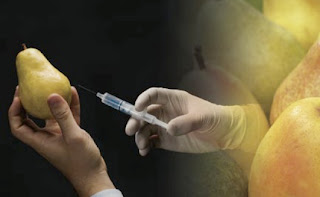Tuesday, August 24, 2010
Nano for Food
Nanotechnology can offer some exciting potential benefits for the quality and safety of our foods. Top 10 Uses of NanoTechnology in Food are:
1. Contamination sensor: Flash a light to reveal the presence of E.coli bacteria.
2. Antimicrobial Packaging: Edible food films made with cinnamon or oregano oil, or nano particles of zinc, calcium other materials that kill bacteria.
3. Improved Food Storage: Nano-enhanced barrier keeps oxygen-sensitive foods fresher.
4. Enhanced Nutrient Delivery: Nano-encapsulating improves solubility of vitamins, antioxidants, healthy omega oils and other ‘nutraceuticals’.
5. Green Packaging: Nano-fibers made from lobster shells or organic corn are both antimicrobial and biodegradable.
6. Pesticide Reduction: A cloth saturated with nano fibers slowly releases pesticides, eliminating need for additional spraying and reducing chemical leakage into the water supply.
7. Tracking, Tracing, Brand Protection: Nanobarcodes can be created to tag individual products and trace outbreaks.
8. Texture: Food spreadability and stability improve with nano-sized crystals and lipids for better low-fat foods.
9. Flavor: Trick the tongue with bitter blockers or sweet and salty enhancers.
10. Bacteria Identification and Elimination: Nano carbohydrate particles bind with bacteria so they can be detected and eliminated.
From Website>> http://www.environmentalleader.com/2009/02/24/top-10-uses-of-nanotechnology-in-food/
Thursday, August 5, 2010
Silicon Chips in Living Cells
Many people have ever seen the movie "Terminator". In near future, we may see a real hybrid human-robot on the street!!!
Researches from Instituto de Microelectrónica de Barcelona, Spain have demonstrated for the first time how to integrate nanoelectronics into living cells. (Ref>> SMALL). At First, they fabricated different batches of polysilicon chips (a typical semiconductor material) and then they selected one with lateral dimensions between of 1.5-3 µm and a thickness of 0.5 µm. It should be note that this dimension is much bigger than nano chip that using 22 nm process technology. Cells for the study were taken from an amoeba (Dictyostelium discoideum) and human HeLa (stem cells from the famous Henrietta Lacks line). The chips were implanted using many techniques such as lipofection, phagocytosis, and microinjection. After inserting the chips into the live cells, the researchers made sure that the cells remained alive and healthy. They found that over 90% of the chip-containing containing HeLa cell population remained viable 7 days after lipofection. The main applications of this chips will be the study of individual cells. The technology could significantly aid early detection of diseases and new cellular repair mechanisms.
Ref>> http://www.nanowerk.com/spotlight/spotid=15292.php
Subscribe to:
Posts (Atom)



